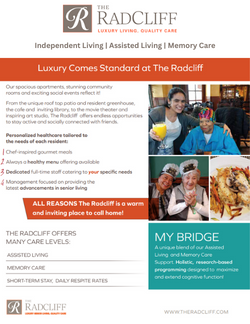The transition from a lifelong home to assisted living can be a difficult experience for both aging adults and their families. This transition represents a significant life change that can be hard to accept. The process of moving is often accompanied by complex emotions and logistical challenges as well as the loss of independence, the adjustment to a new environment, and the emotional strain of leaving a familiar home.
Despite these challenges, assisted living is a critical step for aging individuals who require additional support and care to maintain their health and wellbeing. It is important to approach this change with patience, understanding, and compassion. Understanding the process and preparing ahead of time can make the adjustment much smoother, easier, and less emotional. Here are six ways to help ease the transition to assisted living:
1. Involve your loved one in the decision-making process
It is important to involve your loved one in conversations about deciding to move to assisted living. By doing so, you are respecting their autonomy and allowing them to make an informed decision that aligns with their values and priorities about their life. Additionally, by involving your loved one in the decision-making process, you can gain valuable insights into what they truly want and need. This can help you make a more informed decision about the best course of action. It is also important to start this conversation early. Most people tend to delay talking about this transition, but the sooner the discussion can happen the better. Explain why assisted living is the right choice as well as all of the benefits it provides such as increased social engagement, new friends, a loving community, nutritious meals, fun and new activities, and a more accessible living environment. If your loved one is resistant to the idea of assisted living, be patient and supportive – they will come around!
2. Research different options
Like with any big decision, it is important to investigate all options before choosing one. Most aging adults have negative feelings associated with assisted living facilities such as fear, anxiety, dread, and sadness. However, the goal of assisted living is to enrich ones later years of life, and explaining how the community will do that helps to ease these negative associations. Assisted living facilities vary widely in terms of services, amenities, staff, and culture. By researching different options, you can identify the facilities that best aligns with your loved one needs, preferences, and lifestyle. This can help ensure that you find a facility where your loved one will feel comfortable, supported, and engaged.
3. Familiarize your loved one with the new environment
Touring an assisted living facility before committing to move in is an important step in the decision-making process. It can help families and their loved one to become familiar with the facility, interact with staff and residents, understand daily life, assess suitability, and gain peace of mind. Scheduling a time for your loved one to have lunch or dinner in the dining room, join in on a group activity, or to meet the staff will help mitigate the fear and anxiety around relocating somewhere new. They may even get excited to move!
4. Get to know the staff
Establishing a relationship with staff members can be a great source of support and comfort for both families and aging adults. It is important to feel confident with the people taking care of your loved one by asking questions and building a relationship with them. Knowing your loved one is in good hands goes a long way!
5. Personalize their new environment like home
Downsizing is usually a pain point when transitioning to assisted living. Your loved one has likely formed strong emotional attachments to their belongings and the memories associated with them. Downsizing can also represent a loss of independence. Aging individuals may feel like they’re giving up control of their lives and their ability to make decisions about their living space when moving to an assisted living community. This can be a difficult process, so be patient, offer support, and maintain a positive attitude. By helping your loved one decide what to keep, what to donate, and what to sell can help them to decide what to bring to their new environment to make it comfortable and homey. Favorite belongings, hanging wall art and displaying family photos are all great ways to make their new home more personalized. Going shopping with your loved one for new décor might even help to get them excited about their new space!
6. Plan visits and stay positive
Moving to a new place can be lonely, so plan to have regular visits and check-ins with your loved one. This can help them adjust to their new home more easily while still feeling loved and supported. Be sure to maintain a positive attitude – it goes a long way! Transitioning into a new phase of life is not easy, so remember to be patient, compassionate, and loving.
Making the transition to assisted living can be emotionally and logistically challenging for aging adults and their families. By offering support and reassurance, family members can help their loved ones make a successful transition to assisted living. With time and patience, aging adults can thrive in their new home and continue to enjoy a high quality of life.


